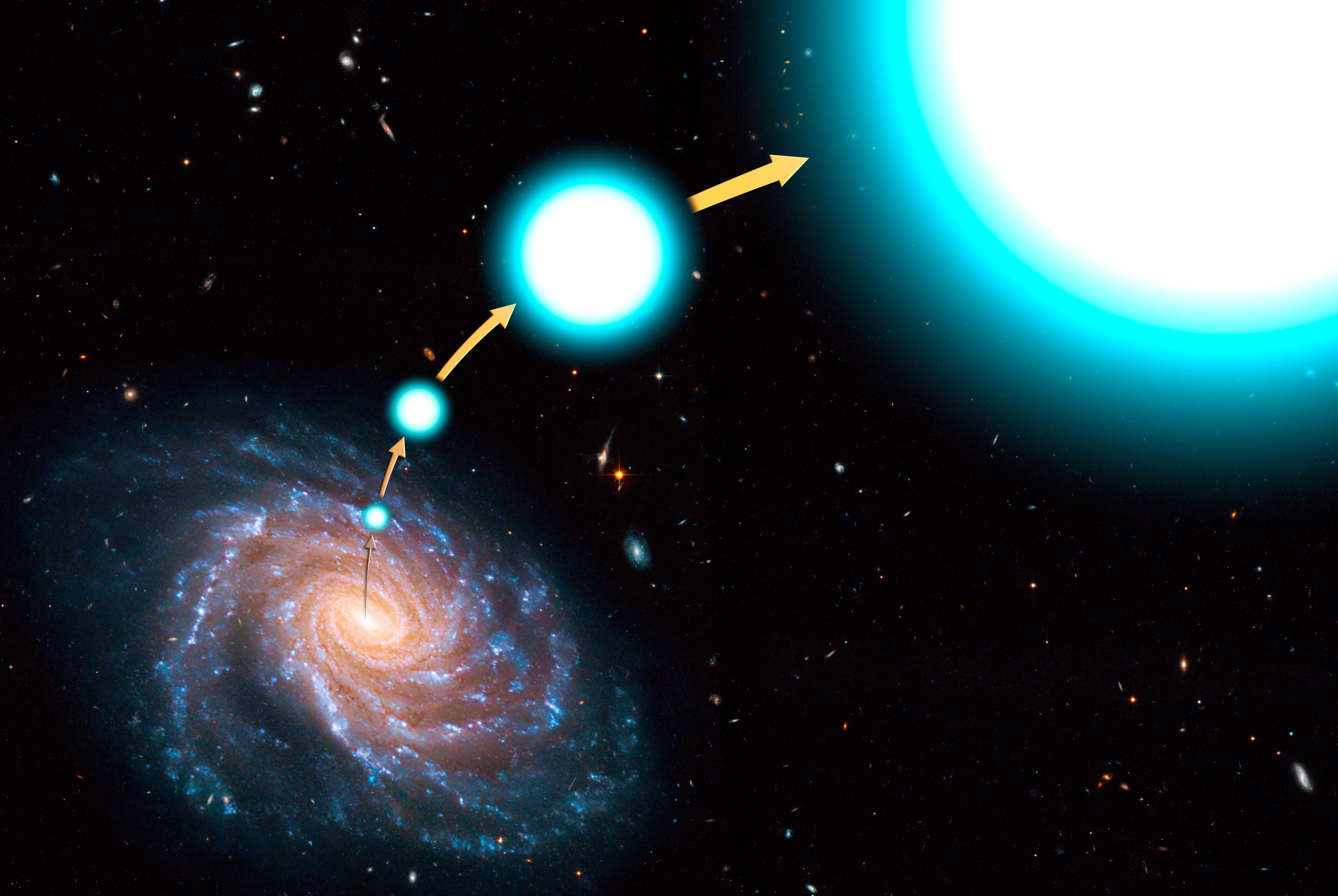Hypervelocity stars (HVS) certainly live up to their name, traveling thousands of kilometers per second or a fraction of the speed of light (relativistic speeds). These speed demons are thought to be the result of galactic or black hole mergers, globular clusters kicking out members, or binary pairs where one star is kicked out when the other goes supernova. Occasionally, these stars are fast enough to escape our galaxy and (in some cases) take their planetary systems along for the ride. This could have drastic implications for our theories of how life could be distributed throughout the cosmos (aka. panspermia theory).
There are thousands of these stars in our galaxy, and tracking them has become the task of cutting-edge astrometry missions (like the ESA’s Gaia Observatory). In previous research, astronomers suggested that these stars could be used to determine the mass of the Milky Way. In a recent study from Leiden University in the Netherlands, Ph.D. candidate Fraser Evans showed how data on HVS could be used to probe the mysteries of the most extreme objects in our Universe – supermassive black holes (SMBHs) and the violent supernovae of massive stars.
The study, titled “Far From Home: The science exploitation of the fastest milky way stars,” was conducted by Evans as part of his doctoral thesis. This consisted of using data obtained by the Gaia observatory, which has mapped over two billion stars in the Milky Way to create the largest 3D catalog of celestial objects ever made. Evans used this to conduct computer simulations where millions of stars were ejected through the Milky Way to get a better understanding of where they originate (and where their speed comes from).
To recap, all stars are traveling around the center of the Milky Way at an average velocity of 100 km/s (62 mps). What sets HVS apart is the fact that their speed is vastly greater than those of other stars, sometimes to the point where they achieve escape velocity. The existence of HVS was first predicted in 1988 by astronomer and Los Alamos National Laboratory Fellow Jack G. Hills, but the first detection was not made until 2005. Thanks to observatories like Gaia and large sky survey telescopes, astronomers have identified more than one thousand HVS since then.
Despite that, many unanswered questions exist about where HVS are most likely to originate and what mechanisms give them incredible speed. Although Evans had no particular ambition to become an astronomer as a child, his studies and research have left him fascinated by hypervelocity stars. “They’re such cool objects. A thousand kilometers per second is extremely fast. You could fly around the world in under a minute,” he said in a recent interview with the University of Leiden. “They also have a story to tell about processes in the universe about which we know little and still have much to discover.”
Most of the HVS studied so far are believed to have originated near the center of the Milky Way, where there is a larger and more tightly-bound stellar population. In addition, many of these stars are gravitationally bound by the supermassive black hole at the center of our galaxy, Sagittarius A*. But astronomers have also discovered fast-moving stars that originated in globular clusters and Magellanic Clouds, hinting that various mechanisms could be responsible. As Evans explained:
“We can assume with fairly great certainty that some of the hypervelocity stars that have now been discovered were ejected following a gravitational encounter with the massive black hole in the center of the Milky Way: Sagittarius A*. We see a similar effect in the Large Magellanic Cloud, another galaxy that we have reason to believe also contains a black hole.”

with a black hole (far left). Credit: ESA
The possibility of a black hole within LMC was confirmed in 2021 by astronomers using the European Southern Observatory’s Very Large Telescope (VLT). This dormant black hole (VFTS 243) was found in the Tarantula Nebula, based on the motion of the stars inside of it, and was the first of its kind detected beyond the Milky Way. Based on his simulations, Evans also concluded that under the right conditions, supernovae could also eject hypervelocity stars from our galaxy. From this, Evans realized that HVS could represent an opportunity to study objects in our galaxy that are difficult to observe.
“The stars that turn into supernovae are incredibly rare in our Milky Way and the event is so short-lived that it is difficult to measure. Added to that, there are so many stars and so much dust flying around Sagittarius A* that we can’t properly see what is going on there. Some hypervelocity stars are flying in more visible parts of space and can tell us more about where they come from. For example, about the gravity of black holes or the amount of energy a supernova produces.”
In this respect, the study of HVS will build on the long history of studying black holes by observing their effects on their surrounding environment. Beyond that, they could offer insight into transient phenomena that are extremely powerful but short-lived (i.e., supernovae). Given the prodigious rate at which HVS are being detected, having a larger sample to study could mean robust scientific returns in the not-too-distant near future.
Further Reading: Leiden University

